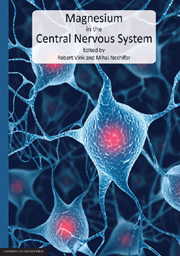Book contents
- Frontmatter
- List of Contributors
- Preface
- Contents
- Section 1 Magnesium in Normal Brain
- Section 2 Magnesium in Neurological Diseases
- Section 3 Involvement of Magnesium in Psychiatric Diseases
- Chapter 18 Magnesium and Alzheimer's disease
- Chapter 19 Magnesium and stress
- Chapter 20 Magnesium in neuroses
- Chapter 21 Magnesium, hyperactivity and autism in children
- Chapter 22 Magnesium in psychoses (schizophrenia, bipolar disorder)
- Chapter 23 Magnesium and major depression
Chapter 20 - Magnesium in neuroses
from Section 3 - Involvement of Magnesium in Psychiatric Diseases
Published online by Cambridge University Press: 05 June 2012
- Frontmatter
- List of Contributors
- Preface
- Contents
- Section 1 Magnesium in Normal Brain
- Section 2 Magnesium in Neurological Diseases
- Section 3 Involvement of Magnesium in Psychiatric Diseases
- Chapter 18 Magnesium and Alzheimer's disease
- Chapter 19 Magnesium and stress
- Chapter 20 Magnesium in neuroses
- Chapter 21 Magnesium, hyperactivity and autism in children
- Chapter 22 Magnesium in psychoses (schizophrenia, bipolar disorder)
- Chapter 23 Magnesium and major depression
Summary
Abstract
Neuroses are a frequently encountered group of psychiatric diseases with a symptomatology including neuronal hyperexcitability, anxiety, panic, phobic reactions, quite frequent tiredness, attention deficit, anorexia or bulimia, and sleep disorders, amongst others. The main pathogenic mechanisms involved in neurosis are increased activity of the glutamatergic cerebral systems (the increased synthesis, presynaptic release and action upon NMDA receptors), an intense catecholamine release, and the decrease of GABAergic cerebral systems activity. In most neurotic patients there is a reduction of plasma and intracellular magnesium concentration. Magnesium administration decreases anxiety, panic and phobia and ameliorates the attention deficit and sleep disorders. We consider that magnesium acts mainly by: a) the reduction of presynaptic glutamate release; b) the reduction of NMDA receptor activity by competing with calcium at NMDA receptor coupled calcium channels; c) the positive allosteric modulator effect at the level of some metabotropic presynaptic glutamate receptors, thereby decreasing presynaptic glutamate release and stimulating GABA release; and d) the decrease of catecholamine release by a direct presynaptic effect under the action of some factors including calcium. The stimulation of catecholamine release under stressful conditions leads to increased magnesium waste that is an essential event in the appearance of the functional cerebral changes characteristic of neurosis symptomatology. Unlike neuroses, neuroticism is not pathologic, but rather a normal state characterized by the dominance of some neuropsychic symptoms. There are data that show that the level of magnesium concentration is lower in subjects with high scores of neuroticism compared with other subjects.
- Type
- Chapter
- Information
- Magnesium in the Central Nervous System , pp. 269 - 282Publisher: The University of Adelaide PressPrint publication year: 2011
- 3
- Cited by

